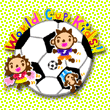
A11. Yes, a great deal of Japanese technology
will be used. Take the referees' whistles, for example, without which no World Cup match could be played.
Since 1982 the official whistles used by referees at the World Cup have been made by Noda
Kakuseisha Manufacturing (Japanese only), a small company located in Tokyo. This company originally
made harmonicas but began making whistles after receiving an order from a U.S. whistle maker. Whistles
made by Noda Kakuseisha quickly developed a reputation for having a beautiful tone, and they began to
be used in the World Cup and in European soccer leagues.
The secret to the whistles' great sound is that each one is carefully handcrafted by six people. A number
of new features have been added to the whistles since the last World Cup in 1998. For example, a larger
mouthpiece makes the whistle less likely to fall out of the referee's mouth. But the sound will remain
the same and will be heard clearly no matter how big the stadium or how noisy the crowd. This "sound
of Japan" will reverberate across the world.
Japanese technology also features in the balls that will be used at the World Cup. The new ball design,
called Fevernova, differs from other soccer balls in more than just looks. Adidas,
the company that developed Fevernova, says that it can be kicked more accurately than any ball ever made.
Molten (Japanese only), a ball maker based in the Japanese city
of Hiroshima, helped Adidas to make Fevernova. Molten has a reputation for its high level of technology,
and it is an official supplier of balls not just to the J. League but also to professional soccer leagues
in countries like Germany, Italy, and Sweden. Some of Molten's technology is used in the Fevernova ball.
The secret to the ball's accurate trajectory is a special layer hidden beneath the artificial-leather
surface. The layer contains countless compressed, durable microcapsules that make the ball bounce. This
special layer is thicker than it was in the balls for the 1998 World Cup in France, and the microcapsules
are aligned more precisely. This means that the balls will react the same whichever part of the surface
is kicked. Many people may be surprised to discover how much technology goes into making a soccer ball.
New technology is also making an appearance in the studs that players wear on the bottom of their soccer
boots. Studs are generally round, but wedge-shaped studs began appearing several years ago. Japanese sporting-goods
maker Asics, though, developed a type of boot that has both round and wedge-shaped studs that help players
maintain a grip on the hard dirt that is typical of Japan. Juan Sebastian Veron, a star of the Argentina
team, will wear boots fitted with these studs in the World Cup. And Mizuno, another Japanese sporting-goods
maker, has used computer analysis to develop boots that are light, soft, and thin. The company has signed
exclusive contracts with top Japanese and Brazilian players to provide them with boots.

Some of the whistles Noda Kakuseisha Manufacturing has made for the World Cup. (Noda Kakuseisha Manufacturing)
